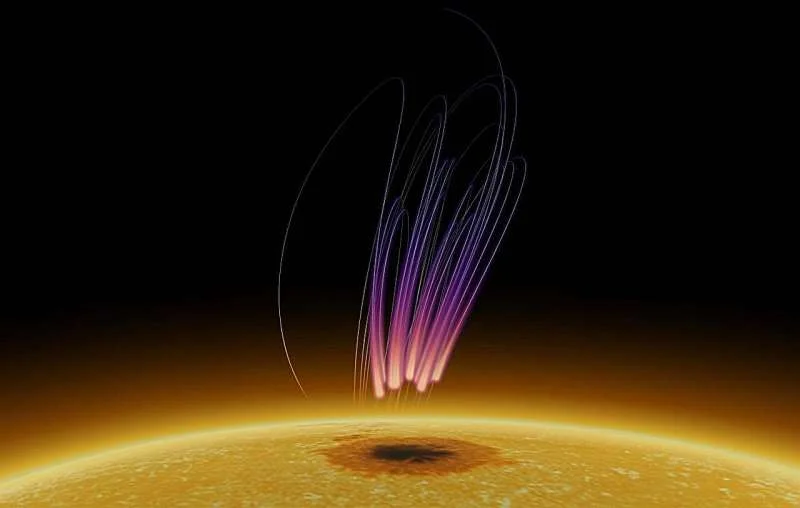In a published study Nature AstronomyAstronomers at the New Jersey Institute of Technology’s Center for Solar-Terrestrial Research (NJIT-CSTR) have made detailed radio observations of a spectacular aurora occurring 40,000 km above a relatively dark and cold region on the Sun known as a sunspot.
The new radio emission shares characteristics with auroral radio emission commonly seen in planetary magnetospheres around Earth, Jupiter and Saturn, and some low-mass stars, the researchers say.
This discovery provides new insight into the origin of such intense solar radio bursts and potentially opens new avenues for understanding similar events on distant stars with large starspots, according to Xiji Yu, lead author of the study and NJIT-CSTR scientist.
“We discovered a special type of long-period polarized radio flare emitted from the sunspot that persists for more than a week,” Yu said. “This is an exciting discovery that could revolutionize our understanding of stellar magnetic processes.”
Famous auroral displays seen in the skies over Earth’s polar regions, such as the Aurora Borealis or Aurora Australis, occur when solar activity disrupts the Earth’s magnetosphere and causes charged particles to fall into the Earth’s polar region, where the magnetic field is located. the field combines and interacts with oxygen and nitrogen atoms in the higher atmosphere. Such electrons accelerating towards the north and south poles can produce intense radio radiation with a frequency of about a few hundred kHz.
Yu’s team says the newly observed solar radio emissions, detected in a broad region of transient sunspots where magnetic fields on the sun’s surface are particularly strong, differ both spectrally and temporally from previously known solar radio noise storms.
“Our spatial, temporal and spatial analyzes show that these arise from electron cyclotron maser (ECM) radiation, which contains energetic electrons trapped within the convergent magnetic field geometry,” Yu explained.
“The cooler, denser magnetic regions of sunspots provide a favorable environment for ECM emission, drawing parallels with the magnetic polar caps of planets and other stars, and potentially providing a local solar analog for studying these phenomena.”
“However, unlike auroras on Earth, these aurora emissions occur at frequencies ranging from hundreds of thousands of kHz to approximately 1 million kHz, a direct result of the sunspot’s magnetic field being thousands of times stronger than Earth’s.”
“Our observations show that these radio bursts are also not related to the timing of solar flares,” added Rohit Sharma, a scientist at the University of Applied Sciences (FHNW) in Northwestern Switzerland and co-author of the study. “Instead, sporadic flare activity in nearby active regions appears to pump energetic electrons into large-scale magnetic field loops anchored to the sunspot, which then feeds ECM radio emission over the region.”
The “radiopolar polar sunspot” is believed to exhibit rotation modulation synchronized with the rotation of the Sun, creating what Yu describes as the “cosmic beacon effect”.
“When a sunspot crosses the solar disk, it creates a rotating beam of radio light, similar to the modulated radio aurora we see from rotating stars,” Yu said. “Since this solar radio aurora is the first detection of its kind, our next step involves a retrospective analysis. We are trying to determine whether some of the previously reported solar flares are cases of the newly identified radiation.”
Solar radio emission, although weaker, is similar to stellar light emission observed in the past and may suggest that starspots on cooler stars, such as sunspots, may be the source of certain radio bursts observed in a variety of stellar environments.
“This observation is one of the strongest evidence of ECM radio emission we see from the Sun. These features are similar to some of those observed on our planets and other distant stars, leading us to consider the possibility that this model could potentially be applied to other stars as well,” said NJIT-CSTR associate professor of physics and “with star spots,” said co-author Binh Chen.
The team says the latest information linking our Sun’s behavior to the magnetic activity of other stars could have implications for astrophysicists to review existing models of stellar magnetic activity.
“We are beginning to put together the pieces of the puzzle of how energetic particles and magnetic fields interact in a system where long-lived starspots exist not only in our Sun but also in stars far beyond our Solar System,” NJIT solar said. researcher Surajit Mondal.
“By understanding these signals from our own sun, we can better interpret the powerful emission from M dwarfs, the most common type of stars in the Universe, that can reveal fundamental connections in astrophysical events,” added NJIT-CSTR Distinguished Professor Dale Gary. . physical
The research team, including Marina Battaglia of FHNW and Tim Bastian of the National Radio Astronomy Observatory, used broadband dynamic spectroscopy observations of radio images from the Carl G. Jansky Very Large Array to make the discovery. Source













